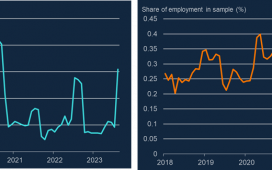Central bankers have been at pains to stress that they can maintain a neat dividing line between actions taken to quell inflation, and those to fix turmoil in the banking system.
So much so that the US Federal Reserve on Wednesday raised interest rates by a quarter point, despite the recent collapse of three midsized US lenders.
Take a look at the central bank’s balance sheet, however, and it is clear financial instability has had an impact on monetary policy. Last week, the Fed pumped almost $300bn into the US banking system after unveiling a new facility, the Bank Term Funding Program. The facility, which offers to take lenders’ US Treasuries off them at par value in exchange for cheap central bank loans, is a direct response to the problems that befell the now defunct Silicon Valley Bank.
Those problems owed a lot to poor risk management, with SVB making an ill-judged, oversized bet on long-dated US government bonds, which have plummeted in value over the past year. At root, however, the sharp reversal in the price of those bonds is down to the actions of the US central bank.
Over the past year, the Fed’s focus on fighting inflation has led not only to bumper rate rises. It has also resulted in the run-off of more than $400bn-worth of US debt from the central bank’s balance sheet as bonds matured and were not replaced.
That came after a long period when the Fed massively expanded its balance sheet under its quantitative easing programme to support markets and the economy by buying bonds to counter the impact of the Covid-19 pandemic. The Fed bought $800bn-worth of bonds between March 2022 and March 2021, and $2trn in Treasuries during the previous 12 month period.
The renewed expansion of the balance sheet is expected to continue in the coming weeks. Michael Howell, managing director at Crossborder Capital, said: “In a world of massive debts, global markets must act as a whopping refinancing system where the capacity of capital — that is, balance sheets and liquidity — is key.”
For some Fed watchers such as Ed Price of Ergo Intelligence, the reversal from contraction to expansion also fuels the sense that we are living through an era of “handbrake-turn” central banking. Fed chair Jay Powell has gone from hinting at a return of large half a percentage point rises to pumping hundreds of billions into the banking system.
In theory, the balance sheet expansion ought to offset the impact of the Fed’s monetary tightening. That does not, however, mean prices are about to spiral. Milton Friedman might have said inflation is always and everywhere a monetary phenomenon, but the money central banks produce is only a small amount of overall supply. In the UK, the reserves, notes and coins linked to the Bank of England make up just under a fifth. The rest comes from deposits held at private financial institutions.
The corollary of those deposits is credit creation. There have already been signs on both sides of the Atlantic that banks are tightening lending standards in response to higher interest rates and lower levels of liquidity.
Powell acknowledged that more tightening was on the way, not only from rate rises, but from the banking turmoil, which would have an effect “equivalent to a hike”. However, no one knows quite how strong that turmoil-related “hike” will prove.
As Claudia Sahm, a former Fed economist and founder of the Stay at Home macro blog, puts it: “No one put bank failures in the toolkit, but the reality is that’s what’s happened.”
Torsten Slok, chief economist at Apollo Global Management, adds: “This is a case of being careful what you ask for. Global central banks have over the past year tried to tighten credit conditions gradually, and with the ongoing headwinds to the banks, the tightening may come a lot faster.”
It is possible that bank turmoil could dissipate, especially if the US limits the threat of bank runs through moves to guarantee all deposits, insured or otherwise. “Households and businesses built up excess savings during the pandemic and there is not so much excess leverage in the system,” Sabrina Khanniche, senior economist at Pictet Asset Management. “The situation now is very different to 2008 as a result.”
But the risk of an uncomfortable scenario still looms for the Fed, where a combination of rapid monetary tightening and banking stress triggers a lending crunch that will have a far more dramatic impact on demand than desired. A lending crunch and slowdown in the economy might help rein in inflation, but it may not be in a way central banks are keen to take credit for.
claire.jones@ft.com





